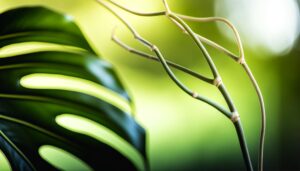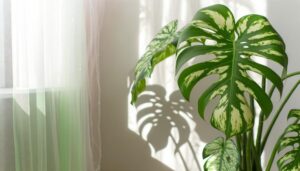Full Grown Monstera Albo Borsigiana: Tips for Optimal Growth
A full-grown Monstera Albo Borsigiana, scientifically known as a variegated Monstera deliciosa, boasts dramatic white and green chimeric variegation on its large, fenestrated leaves. Originating from the tropical rainforests of Central and South America, this striking plant thrives in bright, indirect light and requires high humidity and a well-ventilated, nutrient-rich potting mix.
Maintain steady moisture in the soil, using a hygrometer for precision. Prune regularly with sterilized shears to remove dead or yellowing leaves and manage the plant’s shape.
Curious about more detailed care tips or propagation methods? You’ll want to continue.
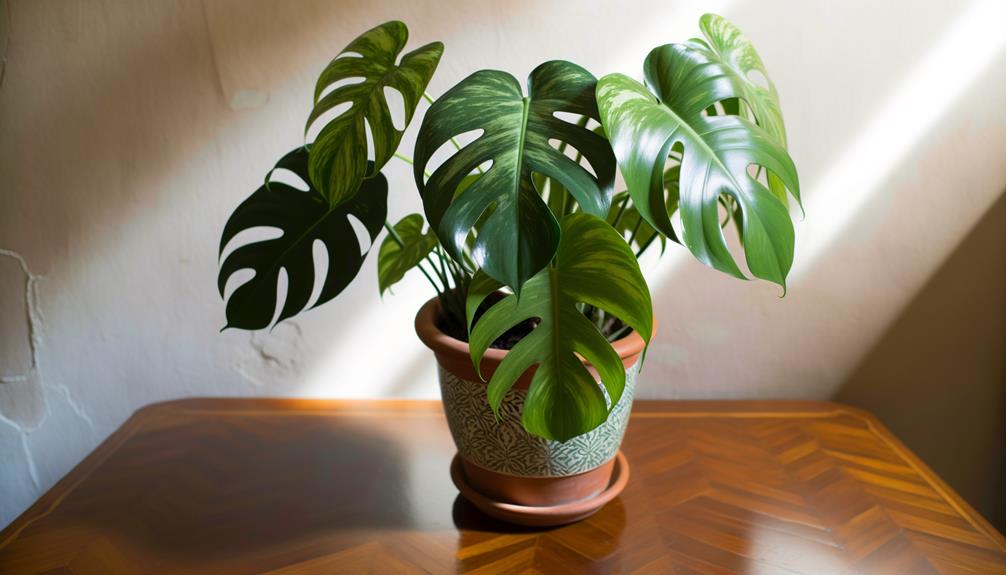
Key Takeaways
- Height: A full-grown Monstera Albo Borsigiana can reach 6 to 10 feet indoors.
- Leaf Size: Mature leaves can be 18 inches wide with significant fenestrations.
- Variegation: Maintains striking white and green variegation patterns on its leaves.
- Growth Rate: Grows rapidly under optimal conditions with bright, indirect light and high humidity.
- Care: Requires regular pruning and maintenance to manage size and promote healthy growth.
Origin and History

Monstera Albo Borsigiana, a variegated cultivar of Monstera deliciosa, originally hails from the tropical rainforests of Central and South America. You’ll find it thriving in the humid, shaded understory, where its aerial roots attach to trees.
This cultivar, with its distinctive variegation, emerged through a natural mutation. Its parent species, Monstera deliciosa, is known for its large, fenestrated leaves and vigorous climbing habit. Over time, horticulturists selectively propagated the Albo Borsigiana for its unique white and green foliage.
In the 20th century, it gained popularity among plant enthusiasts and collectors, eventually making its way into homes and greenhouses worldwide. Understanding its origins helps you appreciate the natural and cultivated history behind this sought-after plant.
Distinctive Features
You’ll notice the Monstera Albo Borsigiana‘s distinctive features immediately, characterized by its striking leaf coloration patterns.
The leaves exhibit a mix of dark green and creamy white variegation, scientifically known as chimeric variegation.
This unique variegated growth results from mutations in the plant’s chloroplasts, producing an aesthetically pleasing contrast.
Leaf Coloration Patterns
The striking variegation on Monstera Albo Borsigiana leaves consists of a mosaic of creamy white and deep green patches, caused by a genetic mutation affecting chlorophyll distribution. These variegated leaves exhibit a remarkable aesthetic, balancing between Albo (white) sectors and chlorophyll-rich sections. The variegation results from chimeric tissue, where some cells lack chlorophyll.
- Dramatic contrast between white and green areas captivates your attention.
- Distinctive patterning makes each leaf an artistic masterpiece.
- Chlorophyll deficiency in white patches can affect photosynthesis, requiring careful light management.
- Eye-catching fenestrations (leaf cuts) add an additional layer of visual interest.
- Delicate balance in coloration requires precise care to maintain the best health.
This intricate variegation is a key characteristic that sets Monstera Albo Borsigiana apart.
Unique Variegated Growth
Admire the unique variegated growth of Monstera Albo Borsigiana, characterized by its irregular, chimeric tissue distribution and precise, sectoral patterns.
You’ll notice the heterogenous mix of green (chlorophyll-rich) and white (chlorophyll-deficient) areas, resulting from a genetic mutation. This variegation follows a non-uniform mosaic pattern, creating an elegant contrast on each foliar surface.
The white sectors may vary in size and shape, sometimes forming marbled, speckled, or even large, pristine patches. This instability in the chloroplast DNA leads to striking phenotypic diversity within the same plant.
Moreover, the asymmetric leaf fenestration, combined with variegation, enhances the plant’s ornamental appeal. Understanding these variegated growth dynamics is key for best care and propagation of Monstera Albo Borsigiana.
Ideal Growing Conditions
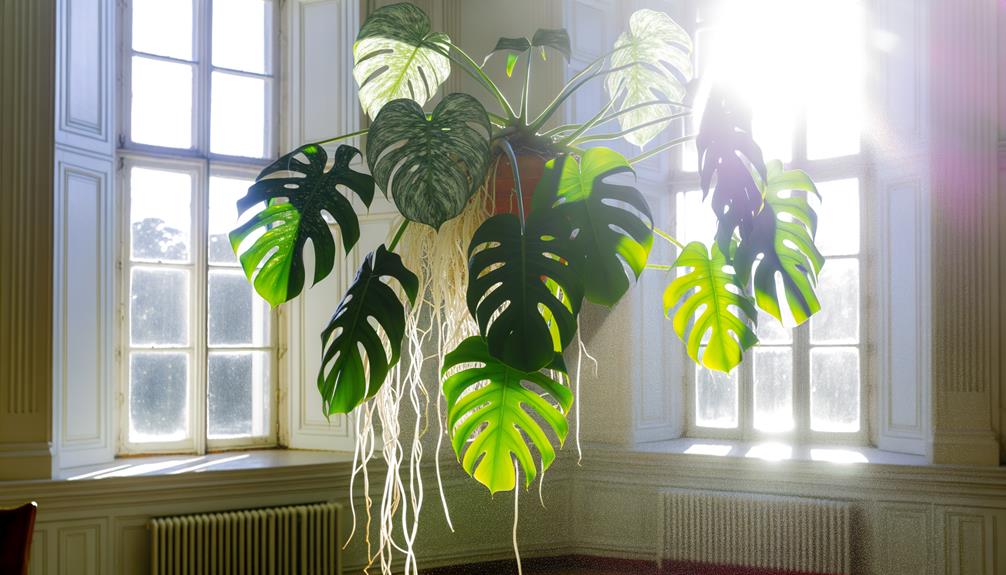
To maximize Monstera Albo Borsigiana’s growth, provide bright, indirect light and maintain a steady temperature between 65-80°F.
Phytophilic enthusiasts must guarantee humidity levels remain above 60% to replicate its native tropical environment.
Utilize a well-ventilated, nutrient-rich potting mix to facilitate root respiration and nutrient absorption. Incorporate organic materials like peat moss or perlite to improve soil structure and drainage.
- Bright, indirect light: Prevents foliage burn and enhances variegation.
- Steady temperature: Supports optimal metabolic functions.
- High humidity: Mimics natural habitat, reducing leaf desiccation.
- Well-ventilated soil: Promotes robust root health.
- Organic materials: Improves nutrient availability and soil texture.
Watering Requirements
When watering your Monstera Albo Borsigiana, make sure the soil remains consistently moist but never waterlogged to prevent root rot and promote healthy growth. Utilize well-draining potting mix to facilitate proper aeration around the roots. Monitor soil moisture using a hygrometer for accuracy. Adjust your watering schedule based on environmental factors like humidity and temperature.
| Environmental Factor | Watering Adjustment |
|---|---|
| High Humidity | Reduce watering frequency |
| Low Humidity | Increase watering frequency |
| Cooler Temperatures | Decrease watering amount |
Ensure your Monstera Albo Borsigiana (Monstera deliciosa var. borsigiana) receives indirect light to avoid rapid evaporation. Over-watering can lead to yellowing leaves and fungal infections, while under-watering may cause browning leaf edges. Always check the top inch of soil before adding water.
Pruning and Maintenance
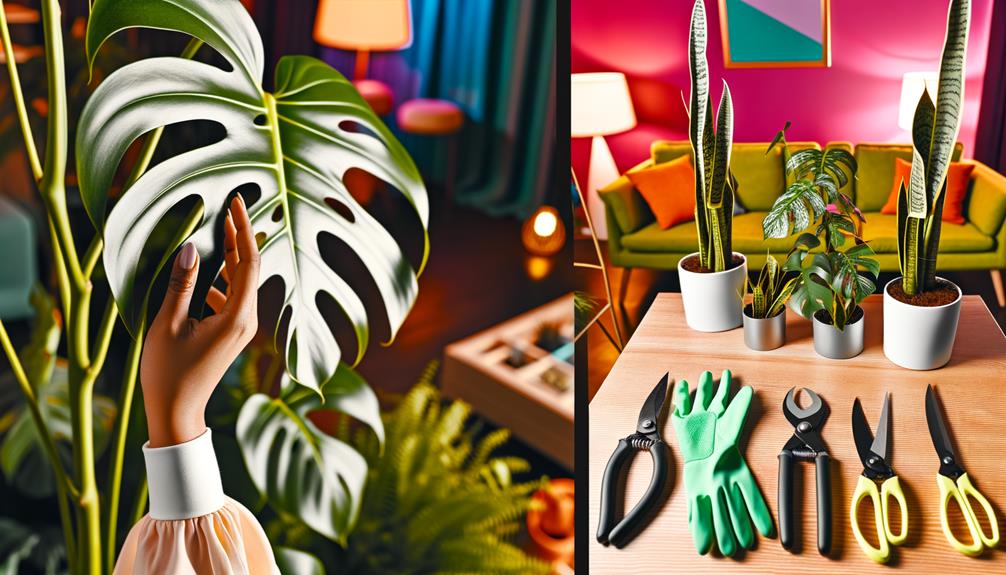
Regular trimming is essential for maintaining the Monstera Albo Borsigiana’s health, encouraging vigorous growth, and preventing overcrowding. By removing dead or yellowing leaves, you allow the plant’s energy to focus on healthy foliage. Use sterilized trimming shears to make clean cuts just above a node. Trimming also helps manage the plant’s size, especially in indoor environments.
- Enhance foliage appearance: Keep those stunning variegated leaves looking their best.
- Prevent disease: Remove any signs of fungal infection promptly.
- Promote new growth: Stimulate the development of new leaves and stems.
- Control plant shape: Maintain an aesthetically pleasing form.
- Improve air circulation: Reduce the risk of mold and pests.
Careful, regular trimming guarantees your Monstera thrives.
Common Issues
Despite its hardy nature, the Monstera Albo Borsigiana can still face several common issues that might hinder its growth and overall health. Root rot, caused by overwatering, can devastate the plant’s root system, turning roots mushy and brown.
Watch for chlorosis, where leaves turn yellow due to nutrient deficiencies, often iron (Fe) or nitrogen (N). Pests like spider mites (Tetranychus urticae) and scale insects (Coccoidea) can infest the foliage, leading to discolored and distorted leaves.
Additionally, low humidity can result in brown, crispy leaf edges. To mitigate these issues, maintain proper watering practices, ensure balanced fertilization, regularly inspect for pests, and provide adequate humidity levels. Understanding these common problems helps you keep your Monstera Albo Borsigiana thriving.
Propagation Methods
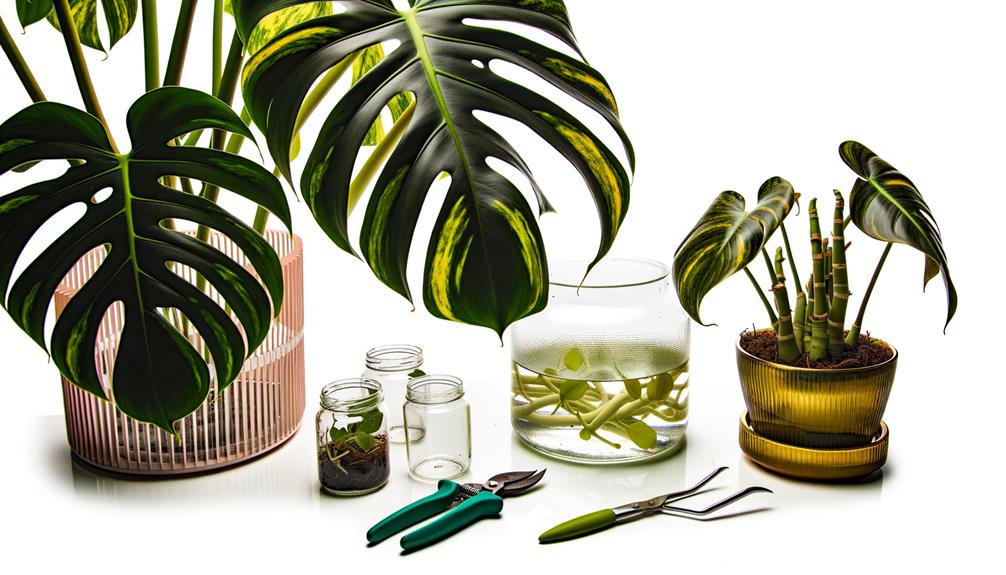
Successfully keeping your Monstera Albo Borsigiana healthy opens the door to exploring its propagation methods, ensuring you can expand your collection or share this stunning plant with others.
There are several techniques to propagate Monstera deliciosa var. borsigiana ‘Albo Variegata’, each with its own scientific merits.
Here are five methods that evoke a sense of accomplishment:
- Stem Cuttings: Use sterilized shears to cut below a node, ensuring at least one aerial root.
- Water Propagation: Place the cutting in water, changing it weekly to prevent stagnation.
- Sphagnum Moss: Wrap the cutting in moist sphagnum moss and secure with plastic.
- Soil Propagation: Plant the cutting directly in a well-draining soil mix, keeping it consistently moist.
- Air Layering: Create a small wound on the stem, wrap it with moist sphagnum moss, and cover with plastic.
Monstera Deliciosa Variegata Borsigiana Album
The Monstera Deliciosa Variegata Borsigiana Album is a variant of the Monstera plant that is highly prized for its unique variegation and aesthetic appeal.
Here are the key details:
Overview
- Scientific Name: Monstera deliciosa var. borsigiana albo-variegata.
- Description: This plant features beautiful fenestrated leaves with striking white and green variegation. The white coloration is typically brighter than that of the Monstera deliciosa ‘Thai Constellation’, but variegation can be unstable, sometimes resulting in all-white leaves or a return to typical green variegation.
Characteristics
- Growth Habit: As a climbing plant, it prefers to be staked or allowed to climb moss poles. It thrives in humid environments, producing aerial roots that enhance its appearance.
- Care Requirements: Requires moist but well-draining soil, bright indirect light, and high humidity to flourish. Regular monitoring is needed to manage the stability of variegation.
Rarity and Market Value
- Availability: Considered rare and often out of stock in many nurseries. Each plant is unique, and variegation can vary significantly from leaf to leaf.
- Price: Prices can vary widely, reflecting its rarity and the demand for variegated plants, often fetching hundreds to thousands of dollars depending on size and variegation quality.
Conclusion
Cultivating a full-grown Monstera albo borsigiana is like raising a rare gem—requiring knowledge, diligence, and care. Master its unique features, ideal conditions, and proper maintenance, and you’ll reap the rewards of an exquisite specimen.
Remember, it’s akin to tending a bonsai; every cut and watering is a step toward perfection. Embrace these methods, and you’ll transform your Monstera into a lush, thriving masterpiece, echoing the grandeur of the Hanging Gardens of Babylon.

